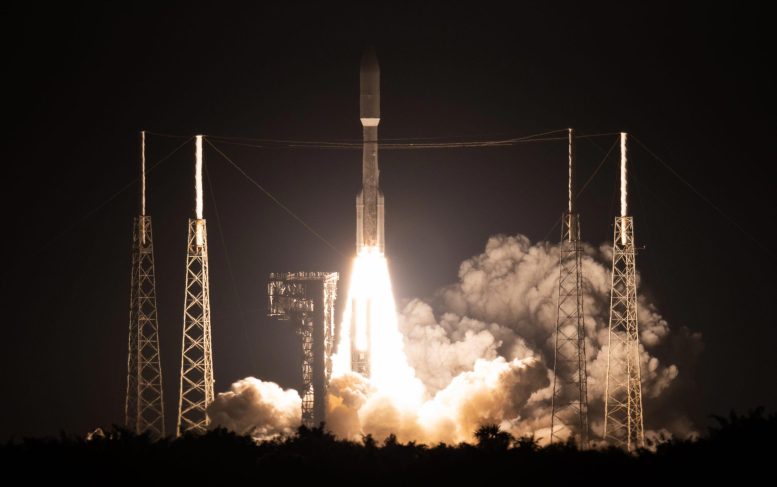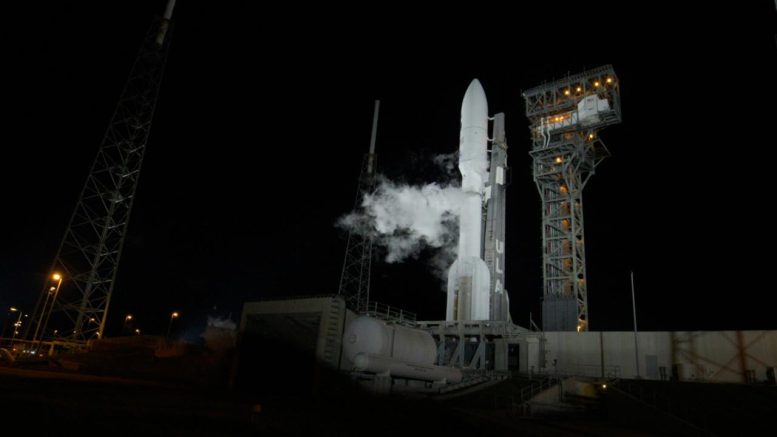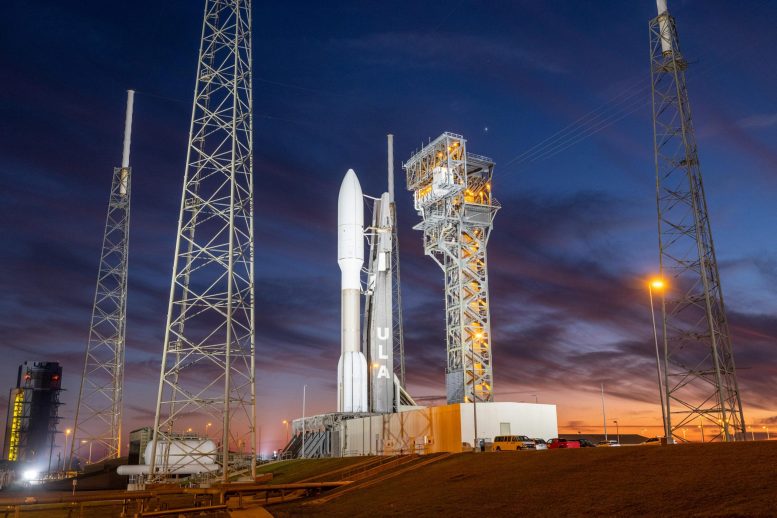
NASA’s Laser Communications Relay Demonstration (LCRD) and a NASA-U.S. Naval Research Laboratory space weather payload to study the Sun’s radiation lifted off at 5:19 a.m. EST on Tuesday, December 7, 2021.
The payloads launched aboard the Space Test Program Satellite-6 on a United Launch Alliance Atlas V rocket from Cape Canaveral Space Force Station in Florida as part of the U.S. Space Force’s Space Test Program 3 mission.
LCRD will demonstrate NASA’s first two-way laser relay communications system, sending and receiving data over invisible infrared lasers, which can enable data rates 10 to 100 times greater than radio frequency systems traditionally used by spacecraft.
“This launch introduces an exciting new technology for space missions,” said Jim Reuter, associate administrator for NASA’s Space Technology Mission Directorate at NASA Headquarters in Washington. “Demonstrating this innovative way of communicating with spacecraft will open the door for this technology to expand the horizons of future space missions.”

The other NASA science payload that launched aboard the satellite was the Ultraviolet Spectro-Coronagraph Pathfinder (UVSC Pathfinder), a joint experiment with the Naval Research Lab that studies the origins of solar energetic particles, the Sun’s most dangerous form of radiation.
“We’re thrilled to welcome UVSC Pathfinder to the heliophysics observatory fleet,” said Daniel Moses, chief technologist in the Heliophysics Division at NASA Headquarters. “This collaboration has the potential to develop a new, high-impact tool with predictive capability for energetic solar particle storms that will enable future space missions, helping us explore farther and travel safer.”
NASA’s LCRD will demonstrate the benefits of space-to-ground laser communications, also called optical communications. LCRD will send and receive data at a rate of 1.2 gigabits per second from geosynchronous orbit to Earth. At that speed, you could download a movie in under a minute. Laser communications systems are smaller, lighter, and use less power than radio frequency systems. These advantages, combined with laser communications’ higher bandwidth, can advance robotic and human exploration across the solar system.

“LCRD is NASA’s key milestone for the buildup of the ‘Decade of Light’ initiative, which involves the infusion of optical technology into space communications and navigation,” said Badri Younes, deputy associate administrator for NASA’s Space Communications and Navigation program at NASA Headquarters. “By the 2030s, we expect optical technology to play a critical role in enabling an interoperable, reliable, and robust space communications infrastructure, providing seamless operations and roaming capability between government and commercial users and providers.”
After launch and confirmation that the payload is working well in space, LCRD will begin to transmit and receive data from its location in geosynchronous orbit – about 22,000 miles above Earth – with ground stations in California and Hawaii using infrared lasers.
LCRD will spend two years conducting experiments, assessing how weather and other changes in Earth’s atmosphere can impact laser communications, and measuring link performance to refine its operational capabilities and processes. Some experiments will simulate relay scenarios between the Moon and Earth to inform how laser communications could one day be used in NASA’s Artemis missions. The experiments and simulations will inform the development of future NASA and commercial missions hoping to utilize optical communications in Earth orbit and for exploration of the Moon, Mars, and beyond.

Later in its mission, LCRD will serve as a relay between an optical communications terminal on the International Space Station and ground stations on Earth. NASA’s Integrated LCRD Low-Earth Orbit User Modem and Amplifier Terminal will allow for the first demonstration of a fully operational end-to-end laser communications system from the space station.
LCRD’s mission, vision, design, and development will be covered in depth in the new season of NASA’s The Invisible Network podcast. Over the course of five episodes beginning on December 7 and each Wednesday thereafter, the podcast will highlight the future of the laser communications technologies this mission is proving in space and the people that are making it happen.
LCRD is led by NASA’s Goddard Space Flight Center in Greenbelt, Maryland, in partnership with NASA’s Jet Propulsion Laboratory in Southern California and the MIT Lincoln Laboratory. LCRD is funded and managed through NASA’s Technology Demonstration Missions program, part of the Space Technology Mission Directorate, and the Space Communications and Navigation program at NASA Headquarters.
UVSC Pathfinder was designed and built at the U.S. Naval Research Laboratory. It was funded through NASA’s Heliophysics Program and the Office of Naval Research. It is managed by the Heliophysics Technology and Instrument Development for Science program office at NASA Headquarters.
STP is operated by the United States Space Force’s Space Systems Command. STPSat-6 was built by Northrop Grumman.
Never miss a breakthrough: Join the SciTechDaily newsletter.
1 Comment
Good